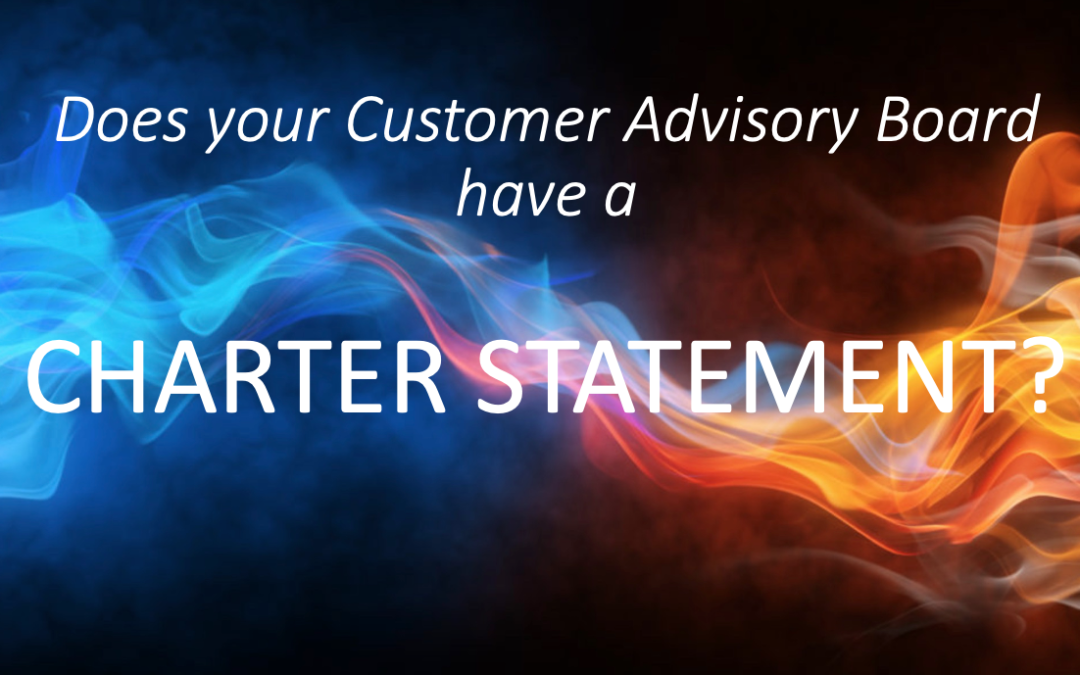As a Customer Advisory Board strategist and advocate for 20 years, I can share that the #1 cause of CAB failure can be linked back to not having a Charter Statement.
A Charter Statement is a one-page document that defines the objectives, expectations, guidelines, and rules of engagement surrounding your CAB program (the entire multi-faceted & integrated program, not just a singular meeting). A version of this tool is used to ensure alignment with internal stakeholders. A “CAB member friendly” version is the first official CAB document shared with CAB members. Its purpose is to clarify CAB member expectations as part of the invitation process so they understand their role and how to prepare for each meeting. In the absence of a CAB Charter Statement, your attendees may assume this is just another vendor meeting. As a result, they may ignore your invitation or delegate their attendance to a junior member.
The Charter Statement provides a drumbeat to your intentions: its message is reflected in your CAB Host’s opening comments in every meeting, as well as the introduction to every CAB meeting output report. In short, the Charter Statement reminds everyone of your company’s promise to having an ongoing strategy-level conversation with a set of your best customers.
What does not having a proper Charter Statement look like? If you have any of these warning signs, it may be time to revisit your approach to your CAB program:
- Senior executives continue to (fight?) debate the value of the CAB program the evening before the meeting.
- Presentation materials are generated the day before the meeting.
- Confusion regarding roles and responsibilities leads to a free-for-all conversation that fails to yield meaningful insights.
- At the end of the meeting an executive comments: “Well that was interesting, but I didn’t learn anything I didn’t already know.”
These warning signs tend to be present in companies wrestling with their first CAB meeting on their own.
In contrast, having a Charter Statement in place leads to positive outcomes:
- Senior executives participate in CAB prep meetings.
- Agendas are designed around “discussion modules” (not presentations) with a minimum of slides.
- There is no confusion on roles and responsibilities. All attendees arrive calm, curious, and energized for a set of well-designed and carefully structured discussions.
- Comments at the conclusion of the CAB meeting include: “That was the best CAB meeting I’ve ever attended. I wish my other vendors designed their CAB meetings where we spent more time discussing topics that matter to everyone, versus listening to a product update lectures.”
Creating a CAB Charter Statement is not tactically hard; however, it does take diplomacy and thoughtfulness. This is the first element we’ll be covering in our live-online CAB Masterclass. I’ll share examples of good, bad, and ugly Charter Statements.

Join our Customer Advisory Board Masterclass
Dates: May 4, 11 & 18, 2022
Time: 8-10 am PACIFIC
What to read next: Planning your 2022 CAB program? Three things you need to know
With a specialty in Customer Advisory Boards (CAB) and Partner Advisory Boards (PAB), Mike Gospe is an advisory board strategist & professional facilitator with more than 20 years of CAB & PAB experience. He’s helped some of today’s most innovative companies deliver more than 200 world-class CAB in-person and virtual meetings. He leads KickStart Alliance‘s CAB practice.

